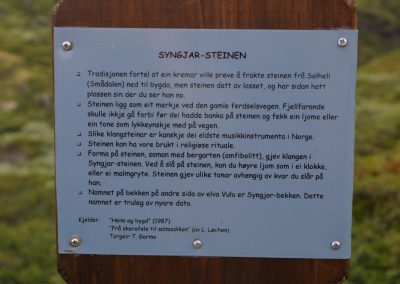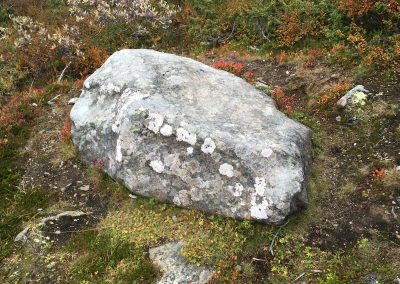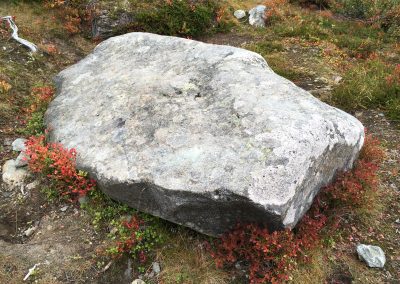The Ringing Stone by Sålell
Type: Ringing stone
Local name: Syngjarsteinen, Klukksteinen
Locality
County: Innlandet
Municipality: Lom
Location: Sålell, Meadalsvegen
The stone is located on the alpine mountain on the southern side of valley Ottadalen. From the main road Ottadalsvegen, turn onto Meadalsvegen at the sign for Soleggen. Follow Meadalsvegen (toll road) for 9.1 kilometres. Then you will find the stone on the lower/east side of the road, directly towards the stream Syngjarbekken on the opposite side of the valley. Look for the signpost by the stone – which you find about 85 meters below the road, at an altitude of 1112 meters.
Description
This oblong, almost oval stone measures 180 x 110 cm, and is 40 cm at its thickest. It is quite flat at the top, and the signpost informs that the rock type is amphibolite. The stone is positioned in the heather, and there are no traces that it has been intentionally placed on top of smaller stones. In 1998 it was cleared of soil and overgrown vegetation. The stone has two pitches depending on where you hit it. The brightest tone (low F) dominates, especially in the thickest and widest end, facing east. At the opposite end, a lower frequency (approx. Db) is heard. The stone has several wear marks, but none of them are very deep or clear.
Cultural history and tradition
The stone is well known among older people in the village, and it is mentioned several times in the local history literature. Leif Løchen (1921–2011) registered the Syngjarsteinen and wrote about it in his book Fra skorofele til salmodikon (2000). He believed that in earlier times the stone was linked to magical performances, and raised the question if this could be the oldest folk music instrument in the country.
One of Løchen’s sources was Lars Rusten (1923–2013), who was well known in the area and who in his childhood had been a shepherd at Skæsarsetra in Smådalen. In some articles he tells about the Syngjarstein. In one text Rusten suggests that the stone was a place where people stopped and played on the stone like a sacrificial sacrifical act: ‘Maybe this was about the same as a varp (like hermes in the Greek traditon) they should not pass before they had thrown a stone on the varp, but in this case that they have knocked on the stone and got a tone, as wish for the journey … Those who passed by here probably had many kinds of errands, and then one must believe that such a bright sound and tone from Syngjarsteinen would make the road easier to walk when they continued on their journey.’
The Syngjarsteinen is one of many natural formations and phenomena linked to the legends of St. Olav. In the book about Garmo Church (1979), Jarnfrid Kjøk writes: ‘… Heilag-Olav travelled a lot. In the area toward Såleil, there was a round stone where he tied his horse. He made the sound in the Klukkstein or the Syngjarstein in Såleil, and in Smådalenbetween Foss and Smådalssætrene he drew his dog on a rock’ (pp. 19–20).
The stone was clearly well known in the village for a long time. In the 18th century, the Syngjarsteinen is mentioned in several written sources. The first was Bishop Peder Hersleb, in the report after his visit to Gudbrandsdal prosti in the 1730s. Among other things, he is asked to report information on antiques, and from Lom he mentions only one, namely a ‘large stone, oblong and about a couple of cubits long and wide, which makes a sound like a bell when you strike then with another small stone. It is therefore called the Singing Stone’. It is apparent that Hersleb—and his informants—believed that this was the most valuable antique the village could present. The stone was later mentioned in sources from 1743, 1775, 1786 and 1796 (see list of sources).
A ‘tradition’ going back to the 18th century sources, is that the sound of the stone got worse or disappeared after it was moved. Lars Rusten (see above) did not agree with this. He wrote (in 1987) that the stone still is found by the old road where it always had been, and added: ‘I have knocked on it several times, and the singing tone is probably as good today as when the first time a mountain man discovered the sound, and named the stream that comes down on the other side and the rock that lies here.’
Sources: Biskop Peder Herslebs visitasbok: Gudbrandsdals prosti 1733–1736. Dølaringen boklag, Lillehammer 1992 (p. 85 and 67); Kristin M. Røgeberg (ed.): Norge i 1743. Innberetninger som svar på 43 spørsmål fra Danske Kanselli. 2: Akershus stift, Hedmark Oppland. Riksarkivet / Solum forlag, Oslo 2004 (pp. 156, 324 and 356); Gerhard Schøning: Reise gjennem Gudbrandsdalen 1775. Norsk skoletidendes boktrykkeri, Hamar 1926 (p. 73); Hugo Fredrik Hjorthøy: Physisk og Ekonomisk Beskrivelse over Gulbransdalen Provstie i Aggershuus Stift i Norge. Anden del. Nicolaus Møller, København 1786 (p. 67); Lars Hess Bing: Beskrivelse over Kongeriget Norge, Øerne Island og Færøerne samt Grønland. Gyldendals forlag, København 1796 (p. 637); Dagningen, 7.11.1978, ‘Kulturminner registrert i Lom’ (p. 8); Jarnfrid Kjøk: ‘Garmo sokn’ pp. 19–34, in Garmo kyrkje og sokn. Garmo Sokneråd, 1979 (p. 19–20); Lars Rusten: ‘Til Smådalssæter i 1935’, pp. 25–28 in Heim og bygd. Lite gåmålt frå Lom, 1987 (pp. 26–27); Nils Vole: ‘Steinbuene i Veodalen’, p. 107–113 in Årbok for Gudbrandsdalen 1987 (p. 109); Gudbrandsdølen Dagningen, 13. juni 1998, p. 49: Interview with Leif Løchen, 77 years; Leif Løchen: ‘Klangstein’, pp. 55–57 in Fra skorofele til salmodikon. Nord-Gudbrandsdal Folkemusikkarkiv, 2000; Lars Rusten: ‘Syngjarsteinen’, pp. 24–26 in Heim og bygd, Lokalhistorisk skrift frå Lom. (11. heftet) 2001; Gudbrandsdølen Dagningen, 25. juni 2002, p. 28: Interview with Leif Løchen; ‘Syngjarstein’, p. 6 in Årsmelding 2007, Sparebank 1 Lom og Skjåk; Leif Løchens handwritten notes.
Thanks to Sylvelin Hege Sevilhaug.
The photos: Leif Løchen (with light shirt) and Gjermund Kolltveit. Photo by G. Kolltveit





